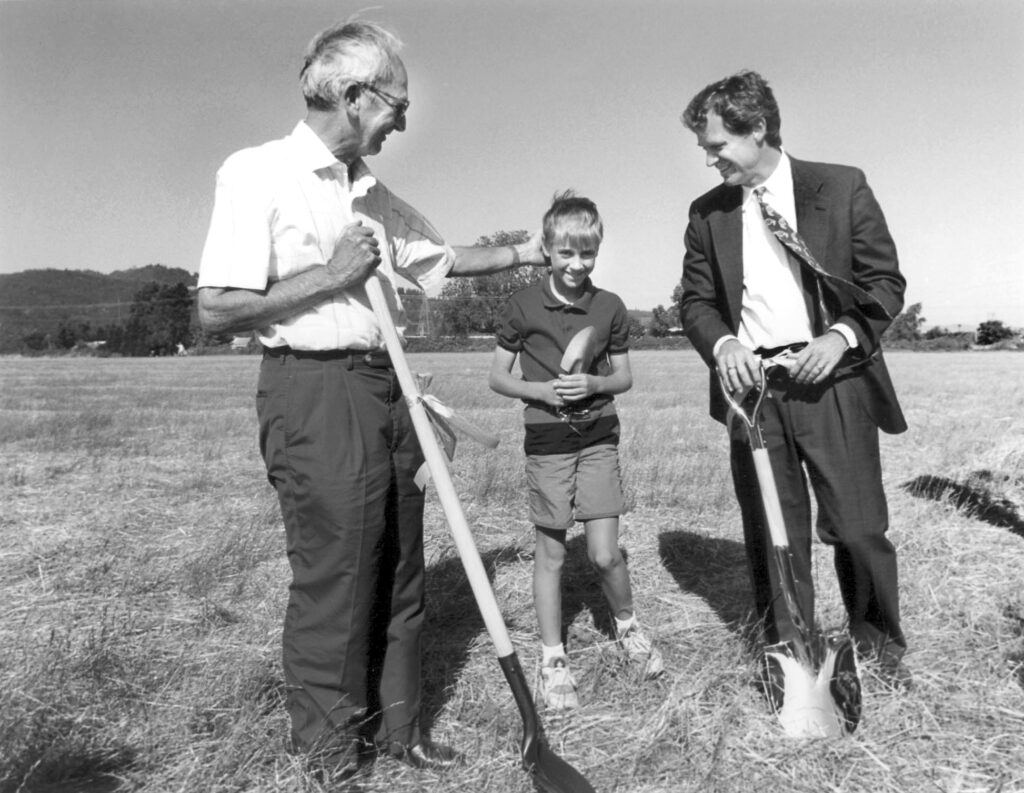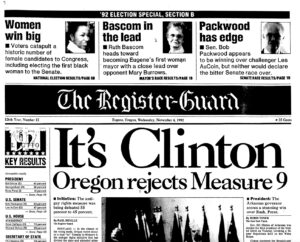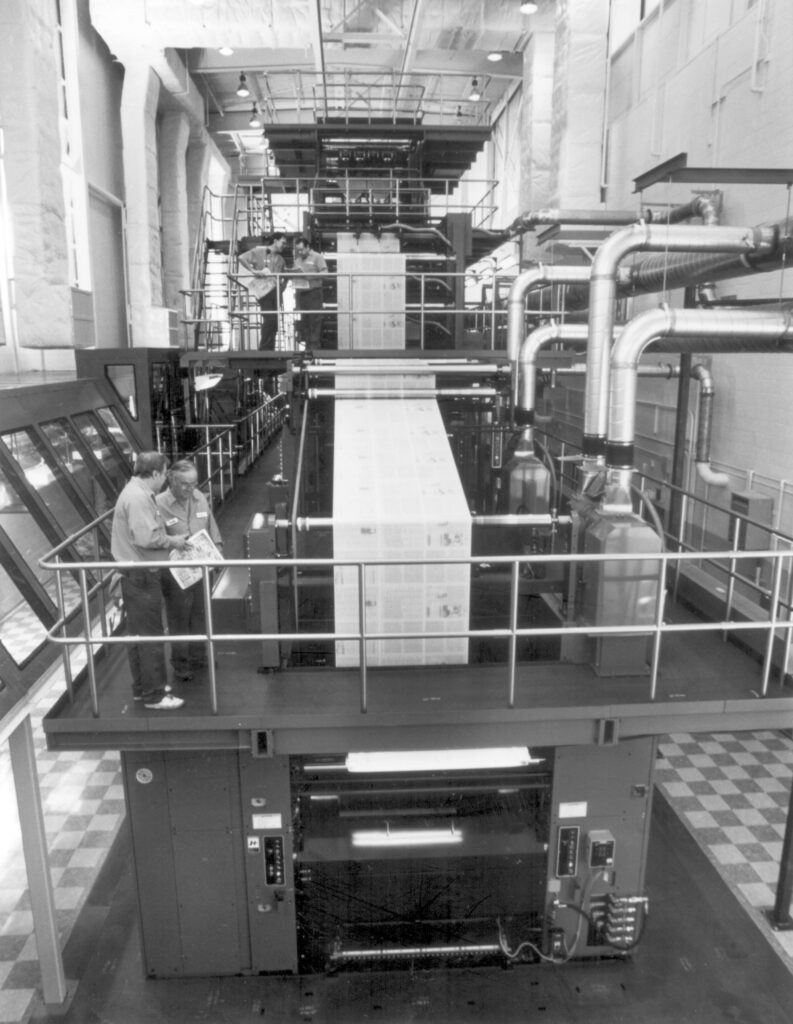Next generation sees changing of the Guard

1987-1997
The front-page headline – “R-G announces new leadership” – that ran on Sept. 1, 1987, made official the commitment by the Baker family’s third generation to running a newspaper that now had 275 full-time employees and an average daily circulation nearing 70,000.
Tony Baker, then 37, who, after spending seven years working around the nation for The Associated Press in the 1970s, had worked his way up from assistant city editor in 1979 to city editor and then managing editor, was named The Register-Guard’s new editor and publisher. And his cousin, R. Fletcher Little, also 37, a 13-year employee and the paper’s advertising director since 1986, was named general manager.

Ted Baker was named chairman of the board, replacing Bunky Baker, who had retired as the paper’s editor in 1986.
Also named to the board were three of Tony Baker and Fletcher Little’s cousins: Ann Baker Mack, who in 1971 was the first full-time employee among the third generation and one of the first female reporters in the newsroom; Richard Baker Jr., today the company’s chief information officer; and Bridget Baker, today the company’s public relations director. The five cousins represented the five branches of the Baker family.
“I look forward to the opportunity and challenge of assuming leadership of the newspaper,” Tony Baker said. “My father and uncle for many years have worked successfully to build and perpetuate a strong, quality newspaper. My goal is to take the paper to an even higher ground.”
The Register-Guard would certainly rise to unprecedented heights under the fourth Baker to serve as publisher.
Average daily circulation would top 70,000 for the first time, finishing at 72,015 in 1989, and an all-time high of 75,576 in 1995. And Sunday circulation came within a whisker of hitting 80,000 in 1993, topping out at 79,715.
The Saturday paper in the ’90s and into the 2000s was the paper’s biggest seller because of the TV Week section the Guard used to run, with Saturday circulation finishing at a record 85,615 in 1994.
But there would, of course, be challenges for Generation 3.
Most Register-Guard employees had been represented by a union, the Eugene Newspaper Guild, since the late 1940s, while pressmen and composing employees have always had separate unions.
But Register-Guard employees had never gone out on strike. A bargaining impasse in 1988 led to the first-ever informational picketing by the Guild, which represents employees in news, advertising, circulation, business and information systems.
The issues were resolved, but the company and the Guild struggled again in the early 2000s, negotiations dragging on for three years before a contract was reached.
In 1989, Guard Publishing Co. bought 43 acres of land near Interstate 5 and Belt Line Road. After 37 years at 975 High St., things were getting cramped, just as they had at 1037-41 Willamette St. in the late 1940s.

In July 1992, the Baker family would gather on their land on Chad Drive, officially called the SummerOaks Business Park, for a groundbreaking ceremony. A bank loan had been secured for what would be a $28 million production plant, which included a state-of-the-art $14 million, five-story, 120-foot-long Mitsubishi Lithopia press that could print a mind-boggling 4.5 million pages per hour – purchased from Mitsubishi Heavy Industries.
The paper’s Harris offset press, purchased in 1975 for $2.5 million with great fanfare, had been disappointing from the start (problems with it caused weeks of late-paper delivery and a drop of more than 8,000 subscribers – from 60,131 to 51,705 – in 1975-76) and it was a nightmare to maintain.
For more than three years, the paper published with its press and distribution crew out at the new location on Chad Drive, and the office building still downtown, before the current $10.6 million office building was constructed in 1997 and the staff moved in January 1998.
Until the big move, though, reporters continued cranking out stories from the old building.
Stories about the northern spotted owl and how its “threatened” status infuriated an already ailing timber industry and significantly reduced timber harvests.
About the economic impact of the new Gateway Mall, built in Springfield in 1990; Sony Corp.’s new $50 million compact-disc factory, built there in 1994; and Hyundai’s huge west Eugene plant, built in 1995.
Stories about Eugene Mayor Ruth Bascom, the city’s first female mayor, elected in 1992; and Eugene Police Chief Leonard Cooke, the city’s first black police chief, hired the same year.
About the Warner Creek Fire in 1991, set by arsonists to block logging near Oakridge, and the subsequent protests there that went on for years; about Eugene anarchists’ vandalism and demonstrations; about the University of Oregon’s historic 1994 football season, resulting in the program’s first Rose Bowl appearance in 37 years; and about the June 1, 1997, clash between Eugene police and environmental protesters in which 40 trees were felled and 22 people were arrested, tear-gassed and pepper-sprayed.

And, finally, a story about that Skinner Butte cross returned to the news on June 12, 1997, when it was finally removed by federal court order from the city park 33 years after it was installed and taken to its new home at Eugene Bible College.
Deemed a “war memorial” by voters in 1970 to get around the separation-of-church-and-state controversy, the cross was guarded on its final day on the butte by a Vietnam veteran with a shotgun.
“You ain’t taking this cross down today,” Rick Ormond told Eugene Sand and Gravel employees when they arrived to remove it.
But, much to the delight of Eugene attorney Charlie Porter, who had waged a three-decade battle to have the cross removed, take it down they did.
Mark Baker, who researched and wrote the stories for this special section, is a former Register-Guard reporter and a member of the third generation of the Baker family.

Mark Baker has been a journalist for the past 25 years. He’s currently the sports editor at The Jackson Hole News & Guide in Jackson, Wyo.
